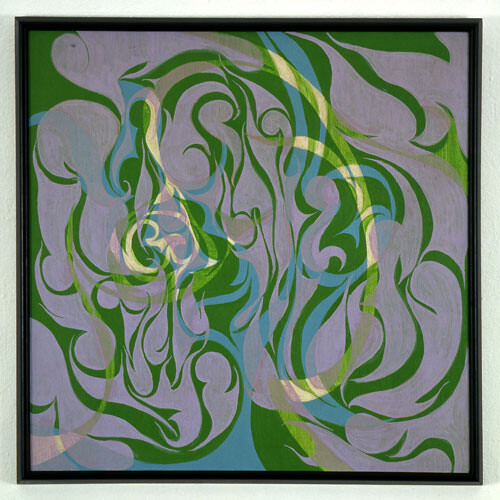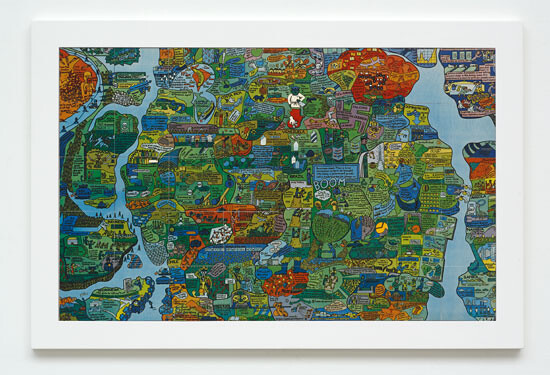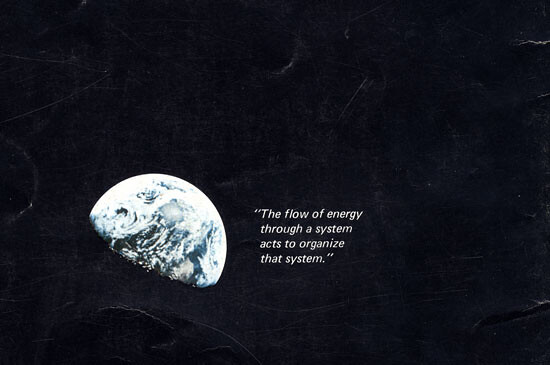“The Whole Earth,” whose first iteration can be seen at the Haus der Kulturen der Welt in Berlin, is a project by Diedrich Diederichsen and Anselm Franke that takes as its point of departure the Whole Earth Catalog by Stewart Brand. In 1966, Brand initiated a campaign for the release of satellite images of earth that he believed NASA possessed, and which he felt would be a powerful icon for the notion of a shared human experience and destiny. One such image graced the cover of the catalog and came to be know as the Blue Marble; it showed the earth as a glowing blue and white globe against a pitch-black background. Brand was also instrumental in bridging the gap between traditionally opposing social groups, like the military—responsible for the space program—and the budding ecological movement. He also forged an alliance between the California counterculture and the emerging fields of cybernetics, computer science, and information technology.
Following in the footsteps of “The Family of Man,” the Whole Earth Catalog testified to the kinship of Mankind, transcending all borders and class distinctions. But the image of the blue planet had a dark side. The Whole Earth Catalog was also used as a tool for anti-Soviet propaganda and gave rise to the lifestyle industry. The California dream was a weak utopia that simply denied political difference and substituted feedback for dialectics. Cybernetics—which had been briefly outlawed under Stalin for conflicting with Marxism-Leninism—extended the presuppositions of thermodynamics to evolutionary biology, neuroscience, anthropology, and psychology. Thermodynamic systems are not subject to dialectical tensions. Nor do they experience historical change. They only accumulate a remainder—a kind of refuse—or increase in entropy. In the 1960s, this refuse surfaced as the Manson Family. At present, the rejects of globalization remain the subject of the global war on terror.
—Ana Texeira Pinto
Ana Teixeira Pinto: Perhaps we could start by introducing the concept of “whole earth,” on which “The Whole Earth” exhibition is based.
Anselm Franke: “The Whole Earth” is an exhibition about the ideas and ideologies that emerged in the wake of the first photographs of the planet earth. The concept of whole earth is also, historically, about the last universalist claim and the last universalist program: the whole earth—this is, the biggest possible frame, allegedly something for the entire “Family of Man.” In our project, we identify three decades, from 1968 to 1998, that stood under the sign of the “blue planet.”
ATP: When you say “blue planet,” you mean the image of the earth as seen from outer space?
AF: Yes, the images of earth viewed from space that emerged around 1968, the most famous of which were made by Apollo 8 and Apollo 17. This turning of the gaze back towards earth signified a change of direction: the expansion-geared, outwards-directed frontier imaginary folding back on itself, in a 180 degrees turn. Ever since, we have been living in this period of interiorization. Nowadays, most accounts of the Space Age—and the Apollo missions in particular—are rife with quotes, especially by astronauts, who claim the whole fuss of the Space Race was worth it because “man” gained a new image of earth, of the planetary condition.
Diedrich Diederichsen: Above all, I think the image of the earth became an argument for a discourse of legitimation and political reasoning. Take the color, for instance. Viewed from down here on the surface, the color of earth was brown, green, even black—it was a dark color. Then all of a sudden, the earth was blue. And blue, up to that point, was the color of the far-away—of the oceanic, of distance, of escape from earth. Blue was the opposite of earth. All of a sudden, these two opposites became one. This constituted a great reversal. Suddenly, the earth meant “planet” instead of the ground beneath our feet.


ATP: Did this image, the Blue Marble, which emerged out of the space program and the first moon landing, bring about a conceptual shift?
DD: From that moment onwards the concept of earth changes in several ways. It becomes simultaneously the starting point and the goal, the far-away place and the familiar. It is blue but also still brown. It is only one planet among millions of others, but at the same time, it’s the only planet we have. The earth becomes more valuable because it can be exhausted. All of these contradictory concepts are perfectly illustrated by this image, which emerges in a specific historical context: at the climax of the Cold War—or one could say, at the beginning of the end of the Cold War. It also emerges at the beginning of the age of immaterial production and digital culture. All of these things were around at that time.
ATP: There is also a correlation between the notion of “system” as it arises from cybernetics and systems theory, and the way the earth starts to be represented as a system in the sense of a self-sealed entity.
DD: It’s important to mention the historical parallel between, on the one hand, the growth of systems theory and cybernetics, and on the other, the development of space travel. Another point is the conceptual similarity between a planet and a system, or rather between the image of the planet and the system. The image of a planet, just like a system, is something you watch from the outside. But at the same time, you’re also inside it. And this is the aporia of the system, because the system always tells us: you can’t look at a system when you’re part of it. But you’re always part of it. And it’s the same with the planet. There is a strong analogy between system thinking and planet thinking.


ATP: I gather that the notion of closure is also important?
AF: We address the motif of closure in the section “The End of the Outside,” which is also the subtitle of the exhibition: “California and the End of the Outside.” This is a trope with many different meanings. Our project sets out to map how these different meanings are conflated in the cultural imaginary of the present, and to help untangle these conflations. Closure as a motif is of course akin to the older notion of naturalization. Regarding the image of the blue planet, one can say that it has both a strong mobilizing capacity and a great ability to naturalize. This produces an interesting paradox: seen from the outside, the image of earth tells us that there is no more outside. To add a wild association: maybe it’s worth drawing an analogy between the aporia that Diedrich mentioned and schizophrenia, which was of enormous significance in political philosophy at the very time when the blue planet image was produced.
ATP: You mean the correlation between capitalism and schizophrenia.
AF: Yes, but it’s not only Deleuze and Guattari who are reconceptualizing schizophrenia at the moment when this image emerges.
DD: LSD use was described as artificial psychosis and artificial schizophrenia. The higher consciousness of the LSD-enlightened person was regarded as an artificially induced schizophrenic state. The new humans, who took LSD, were all happy schizophrenics.
ATP: Can you elaborate a bit further on the connection between the whole earth and the notion of the split subject?
AF: The image of earth is, in many ways, a paradoxical one. And one paradox—or aporia, as Diedrich pointed out—is the position of viewing from the outside a system to which we are at the same time immanent. That is, whenever you look at or talk about this image, you are actually surfing a sort of schizo-meridian, a borderline between being part of it and being on the outside of it.
DD: The position of whoever took the photo of the planet while looking at it from outer space is like the voice that you hear in your head when you are schizophrenic. You don’t know where it’s coming from. Of course, the voice that you hear is nothing but your own thinking. Yet your own thinking seems like a voice from afar uttering commandments. That’s exactly the situation with the concept of the “visible planet.” I think that’s a very fitting description.


AF: In our project, we operate with a couple of fictions, a set of hypotheses. One could be described as follows: let’s say that the image of the earth carried a message, which had a very strong influence and reached a lot of people whose diverse worldviews assembled around this image. Let’s say that Stewart Brand’s Whole Earth Catalog was its official medium, because Steward Brand appointed himself as the messenger. Everything the image had to say was then written in the pages of the catalog. This is how the image of the blue planet gets grounded in the concrete environment of California and the historical momentum of the Cold War and the counterculture. This image also anticipates the end of the Cold War. In it, the earth is already whole, without boundaries or borders, analogous to post-1989 global capitalism and the oceanic, interconnected globe of the 1990s. After 1945, the blue planet replaces the mushroom cloud as a universalist icon. Under its sign a new period begins, a new world order. Our aim is to inscribe this new planetary systemic paradigm into several historical continuities: above all, into the continuity of the Western-modern-colonial frontier, which, contrary to the common impression, does not disappear, but rather becomes a universal—that is, a permanent—condition. This is very different from believing that, like the Berlin Wall, all “old divisions” will soon disappear. Another noteworthy continuity is that this image is actually the product of Wernher von Braun’s invention, the V-2 rocket. The V-2 rocket is the first man-made object in space, and it has a television camera on it. That is, in terms of its technology, the birth of the Blue Marble was in complete continuity with the program that von Braun took to the US, where he developed the rocket program for the military. The first images of earth are, literally, V-2 images.
DD: Through his insistence on the photograph of the blue planet as an element of the Whole Earth Catalog, Steward Brand also appropriated space travel and NASA and astronauts for the counterculture, while at the same time reconciling the romanticism of the counterculture with advanced technology. Needless to say, this reconciliation between romanticism and futurism becomes the basis of digital and internet culture. On the other hand, the image of the blue planet was also tied to early rocket science, which had already made this connection between reactionary romanticism and novel technology. This is present, for instance, in the idea of bringing people back to live on their homeland, conquering the earth that belongs to them, and all these kinds of racist German projects. One could say that Pynchon’s Gravity’s Rainbow comes back, in a way, through the Whole Earth Catalog.
AF: It is especially interesting to follow this connection throughout the 1970s, because this alliance between technology and romanticism was always a very fragile one. In the short period when Steward Brand acted as an official advisor to California Governor Jerry Brown, they organized a “Space Day” financed by California’s aerospace industry. Space Day featured astronaut Russell Schweickart, who had famously said, “From up there, there are no frames, no boundaries.” Schweickart sat next to Jerry Brown, Carl Sagan, and Gerald O’Neill, who was a major advocate for space colonies. Stewart Brand managed to stir a huge debate among his readers, who were the core of the California environmental movement. The technology/nature divide, and the question of whether to act outside or inside the system of big business and the military, broke open, only to close again shortly thereafter. It’s an odd mix. In the environmental movement, many hated the space colony stuff. For them, it was big industry, it was everything they were fighting against.
DD: Timothy Leary was very much in favor of space colonies. Though society in general mocked it, Timothy Leary supported the idea.
ATP: So the Blue Marble functions like a tangled skein out of which one can pull several threads?
DD: One important point is the conjunction of these discourses, which are usually contradictory. Another important point is that this conjunction of binary opposites has something to do with the structural oddity of photographing, or observing, the territory that you are, at the same time, inhabiting. That is, you direct the gaze of desire—which, in relation to territory, always meant colonial desire—towards the place on which you are already standing. This is the formal reason why all these binary oppositions collapse, or mingle, or develop a dialectical synthesis. In one way or another, the culture has to process this problem. Whatever you project upon this image, it will behave accordingly. And then it’s up to the specific propagandists and cultural activists to do something with it.
AF: I think the biggest question is how to find a narrative to account for this synthesis, this reconciliation of binaries, this conflation of opposites, which is still going on. This appears as a historical process with its own logic and necessity, and I suppose it’s worth wondering about the underlying structures that create this necessity. There is a larger narrative at work in the whole earth project: the narrative of the general cyberneticization of the epistemological-technological apparatuses of Western modernity after 1945. It is, in a way, a slow embrace of what was previously excluded from the constitution of the modern social and epistemological order: the irrational, the mimetic (contagious or playful), the animistic. These become the new resources. There is a structural affinity between the synthesis of opposites—or the desire for such a synthesis—that occurs under the aegis of the blue planet, and what Freud and anthropologists like Edward Tylor used to describe as the animism of pre-modern people. Both involve a conflation of binaries. The cyberneticization of the world also becomes its re-animation, a project of undoing alienation, a desire for immersion and enchantment. The once fixed, objectified, reified world begins to be dynamic, talkative, and transformative again—but at the price of immersive adaptation to systemic conditions. This results from transporting cybernetics from the fields of mathematics and computing into social theory, and—after cybernetics was made credible via psychedelic experience—into the world at large. This leads to such things as the immanent mind and a conception of nature as an animated information system. The counterculture also becomes depoliticized to the degree that it embraces visions of spontaneous harmony and neo-animistic conceptions of the whole. All of this was derived from the new cybernetic reality principle: communication, the medium, the in-between.


ATP: Would you say that feedback shares a kinship with animism?
AF: Yes. There is a structural affinity.
ATP: If I get what you’re hinting at, one could say that cybernetics mirrors the main insight of structural linguistics: that language can be interpreted as a formal system of differential elements, which is also how Lacan addresses desire.
DD: Let me put it like this: when systems theory tries to solve the problem of epistemology, the major structural question it asks must be answered both at the level of content and at the level of fantasy, the imaginary. Lacan looks at desire as a structural dilemma, the same way systems theory looks at science and cognition. There are two ways to respond to this: one is embracing the paradox, the other is getting rid of the subject and letting cybernetics take over.
ATP: In systems theory and first order cybernetics, you might say that information is the coefficient of freedom. Mathematically speaking, the freedom of choice is between a 1 and a 0.
DD: But what Anselm was describing—the origin of all these ideas of harmony and conservation—has a lot to do with the notion of desire in the sense of not having a choice. You don’t even have a small choice. It’s what humans have to want. It’s not what we want. We have to want. We have to love each other. It’s not that we really do. But we have to. And hippie culture is about how we actually do love each other. Come on people now. Smile on your brother. Everybody get together. Try to love one another right now. Try to, but …


AF: Cybernetics also entails a transformation from static to dynamic, from linear to circular models. Before the word “feedback” came into being, it was called “circular causal relations.” This phrase was used at the Macy Conferences. The introduction of the circle is basically what culminates in the Blue Marble. The entire process that produces this new ideological matrix is structured upon a transition from linearity to circularity. That which is one-directional becomes the devil. This ranges from hierarchy to the scientific understanding of cause and effect. With cybernetics—particularly when cybernetics steps into the social sciences and humanities—you have an interesting witch hunt starting, an anti-Cartesian witch hunt, a general anti-dualist witch hunt. This culminates in the fall of the Berlin Wall, which stood as a mega-symbol for the bifurcated, linear, static, objectified world. The point now is to see and focus on the dialectics of this process—the degree to which the doors that were opened eventually closed upon themselves, the degree to which dynamization produced new static fixities.
ATP: Anselm, I believe you used this image of the closing door to illustrate how, when you see the earth from outer space, just at the moment when you would expect a door to open towards the expanding universe, it suddenly slams in your face.
DD: In Roberto Bolaño’s last novel, the protagonist, who has been a heterosexual man all his life, finally discovers his homosexuality. The chapter in which this occurs is called “The Fall of the Berlin Wall.”
ATP: Couldn’t you also say that the Cold War is the perfect expression of a cybernetic model? Cybernetics defines itself by establishing an operational dichotomy between system and environment, which, in turn, gives rise to the concept of “information” as what the system extracts from its environment. The field of game theory, for instance, is based on the psychology of the Cold War: two players, one on each side, neither of whom knows what the other is thinking. For each player, the other is the environment from which they aim to extract information, forming a perfectly enclosed feedback loop.
AF: There’s a great book on that called The Closed World. But there are two lines of inquiry here which we can interestingly juxtapose. One is the RAND Corporation game theory model, which is based on the mimetic economy of war. But this is old stuff. Clausewitz already described this strategic guesswork—how you necessarily become like the enemy, which generates a closed system. But then there’s the other model, this planetary unity fantasy, where there are no more opponents—an oceanic mimetics, not an antagonistic mimetics. In that sense, the Blue Marble anticipated the end of the Cold War, or induced it with the principles of sympathetic magic.
DD: I think the Cold War already contains the end of the Cold War. It’s a permanent element of it. You can observe it now. The situation in Korea in a kind of grotesque reenactment of the Cold War. You had the same situation in the Cold War, in that it had all these components of communication, which were basically symbolized by the red telephone: the symbol of the notion that communication would prevent the Cold War from becoming hot. The bottom line of the Cold War is that it’s cold which is to say that war is not happening. And war is not happening because of communication. So communication can also lead us out of any war situation. That is why the whole feedback idea became such a glorified element of countercultural lifestyles, theories, pedagogies, psychologies, and music: there was nothing people liked more than a long feedback loop—which, at a concert for example, became a moment of total communion for all the bodies in the audience.
But my favorite example is the story of the blues. Under Jim Crow in the US, there was, of course, segregation. There were radio stations for black music and radio stations for white music. But then the counterculture brought in all these white musicians who adopted black music. Certain black stars also played at white festivals. Around 1969, the major record companies adapted to this new situation, assuming that they no longer had racially separated markets. CBS did a huge double-album compilation with white and black musicians. It was called The Blues. And what was on the cover of this album? The Blue Marble. Because it’s blue? No. Because it could express the idea of overcoming a distinction.
AF: It’s the universal formula for overcoming distinctions.
ATP: Speaking of which, I would like to go back to the idea of the American frontier or the space frontier as the capitalist frontier. How is the moment of primitive accumulation continuously actualized in these iterations of the frontier imaginary?


AF: In the 1890s, the Census Bureau of the United States announces the closure of the frontier. Around the same time, the colonization of the world elsewhere is basically complete. The scramble over Africa is over. This closing of the frontier concerns the entire globe. All of this also happens at the same moment as the Chicago World’s Fair. It’s not the first World’s Fair, but in a strange way, it’s the first to embody this moment of a planet-wide closure of the modern, Western, colonial, capitalist frontier. It also announces a period of intensification for electricity and communication technologies. At the same time, the conservation movement begins to see nature as no longer an inexhaustible resource, but as an enclosed “outside” to be protected and conserved—a big shift in attitude. Freud and William James conceive of the psyche and the mind as closed systems without an outside: the unconscious and the irrational are part of the system. They are inside the circle. In the 1960s, the outside is a utopian site: outside of “the system,” outside of the “technocracy,” outside of alienating, conformist mass society and its “objective consciousness” and hierarchies. The outside—the imagined, produced, or actually remaining outside—becomes the source for the transgressive ideas of the counterculture. Hippies call for a return to nature. The psychedelic counterculture, the Human Potential Movement, and the anti-psychiatrists attempt to liberate the self by embracing the irrational and setting it free, rather than trying to control or repress it. Another paradigmatic outsider of Western colonialism—the “native”—is embraced in the form of neo-primitivism. The American Indian, for a short time at least, is hailed as a role model for non-authoritarian, harmonious, and tribal forms of community. But the most important point is to see that with the closure of the frontier, there is a passage from the linear to the circular.
DD: This is similar to the idea of circulation—capitalist circulation—in Marxism.
AF: The period between 1890 and 1960 was also the period when the idea that capitalist modernity would turn souls into mere things—the idea of reification—was most viral.
DD: Or what the situationists called “the critique of separation.” If all these leftists are criticizing capitalism via a critique of separation, voilà: here’s a whole.
ATP: I have a question concerning the political aspects of this shift. There’s basically one epistemological model to explain historical change, and that is dialectics. I have always thought of cybernetics as a reversal of dialectics: although feedback and dialectics represent motion in similar ways, dialectics implies a fundamental tension, an unresolved antagonism from which a novel system may emerge, whereas feedback knows no outside or contradiction, just perpetual iteration. One could say that feedback is dialectics minus communism. That is, feedback, if seen as an epistemological model, precludes change on a material, political level—or better put, change can only appear in terms of (self-)adjustment. In other words, cybernetics provides for a smooth transition from political philosophy to economic theory.
DD: Yes, but cybernetics is really a non-historical model of change. It doesn’t distinguish between historical situations. It distinguishes between states. It only has states. Things are in certain states. But since they form only one part of a network, the whole will not change. By definition it cannot change. It can only be in different states.
ATP: It’s a recursive system. Change can only be represented as iteration.
DD: It will iterate, iterate, and iterate, and it will never be different. But we’re describing first-order cybernetics. Once we introduce the problem of the observer, it’s not that easy anymore. I would say that in late systems theory, and late Niklas Luhmann, that blind spot becomes more than just a technical blind spot. It becomes dramatized—when he finally realized, for example, that there was more than Europe.
ATP: How do you position yourselves critically towards cybernetics and systems theory?
DD: We frame it as ideology, and we locate this ideology historically. You could even call it a superstructural phenomenon—although it’s more than a superstructural phenomenon, because it creates material reality. Basically, it’s the beginning of post-industrial capitalism.


AF: Returning to the beginning of our conversation, I think it’s important to contemplate where the Blue Marble has led us. I want to insist on this ambivalence between being both a structural critique of something and a symptom of something. There is this cover of Wired magazine from 1997. It’s ugly, like most covers of Wired magazine. It shows a huge smiling blue marble and has a headline that says “The Long Boom.” The corresponding article inside predicts twenty-five years of global unity, prosperity, and growth. When you read it, you realize what the Nineties made of the ideas of the Sixties: they turned them into visions of magically expansive and self-balancing technological, biological, financial, and social systems—it has all become one and the same. In retrospect, the Sixties looks like an attempt at self-therapy, an effort to recover from the huge trauma of planning. The trauma of linear planning in the twentieth century was so strong that this California avant-garde embraced everything that had to do with feedback and emergence, as if this was their pharmacon against planning. Even when it became clear that they could not overcome the problem of political planning by just embracing systems rhetoric and mimetically likening society and technology to an ideal system-built nature—even in the moment when this became clear, they went one step further into a kind of beyond/delirium mix, deeper into the fantasy of a completely organic capitalism. This is the power of the call to move beyond binaries. It’s a tendency that tries to forget the schizoid condition that prevails: namely, that you are supposed to attain a condition of dynamic immersion, which at the same time has been declared as already universally existing. The point today is to see how the program of opening doors has actually closed them, to see how systems can act in conservative or demobilizing ways.
ATP: This IT ecological fantasy is also connected to the denial of materiality. When one says that the digital era has outflanked industrial production, one always speaks as if digital technology has no material aspect, as if no labor or resource exploitation are involved.
DD: It’s not only the digital. The entire California fantasy deals heavily with immateriality, especially with immateriality understood as spirituality, where the opposite of the material is not immaterial labor but spirituality—which is, of course, a form of immaterial labor, but glorified and ideologized. I think the question is: What is the leftover from that idealization and ideologization? Where is the symptom produced by the failure of this maneuver? Before one can know the answer to this question on a political level, it will emerge on a symptomatic level, or in the acts of individuals. I’m referring, of course, to people like Charles Manson—not so much the real Charles Manson, but the mythical Charles Manson as he appears in Neil Young’s song “Revolution Blues.” The first-person narrator in the song is precisely the leftover of the California ideology, and he has identified two enemies: the computer and the culture industry, represented by the stars who live in Laurel Canyon. He wants to kill them. And he has an army with rifles and dune buggies in the mountains who come down to do it. That, I think, is the leftover, the material basis.
